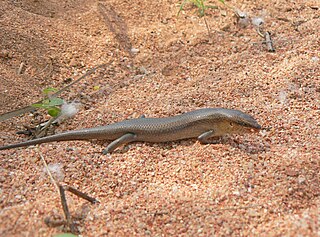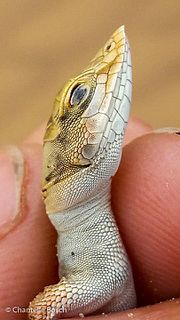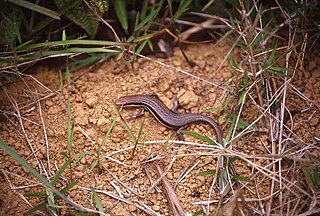Lubuya is a genus of skinks, lizards in the family Scincidae. The genus contains one species, Lubuya ivensii, known commonly as Ivens's skink, Ivens's water skink, or the meadow skink, which is endemic to Southern Africa.

Chioninia coctei was a species of lizard that was at one time known to inhabit the islets of Branco and Raso in the Cape Verde islands of the Atlantic Ocean, rendered deserts by human-caused habitat destruction. None have been observed since the early 20th century, and the species was officially declared extinct in 2013.
Melanoseps is a genus of lizards, known commonly as limbless skinks, in the family Scincidae. The genus is endemic to Sub-Saharan Africa.
Sepsina is a genus of skinks. The genus is endemic to southern Africa.

Typhlosaurus is a genus of African lizards, one of a number of genera of limbless lizards in the skink family (Scincidae). This group was recently revised with most species formerly attributed to Typhlosaurus now placed in Acontias. The current definition of Typhlosaurus includes five attenuate body legless lizards from southwestern Africa. This is the sister genus to Acontias, which together form the well supported Afrotropical subfamily Acontinae.

Latast's snake skink is a species of skink, a lizard in the family Scincidae. The species is endemic to the Near East.
Günther's dwarf burrowing skink or Günther's burrowing skink was a species of skink in the family Scincidae. S. guentheri was endemic to Natal, South Africa.

Hakaria is a genus of skink, a lizard in the family Scincidae. The genus contains one species, Hakaria simonyi, which is endemic to Socotra.
Trachylepis bayonii, also known commonly as Bayão’s skink, Bayon's mabuya, and Bayon’s skink, is a species of lizard in the family Scincidae. The species is endemic to Africa. There are two subspecies.

Otosaurus cumingii, commonly called Cuming's sphenomorphus or the Luzon giant forest skink, is a species of skink, a lizard in the family Scincidae. The species is endemic to the Philippines.
Chioninia stangeri is a species of lizard in the family Scincidae. The species is endemic to the Cape Verde Islands.

Monopeltis anchietae, also known commonly as Anchieta's worm lizard, Anchieta's spade-snouted worm lizard, and the Angolan spade-snouted worm lizard, is a species of amphisbaenian in the family Amphisbaenidae. The species is native to southern Africa.

The shovel-snouted lizard, also known commonly as Anchieta's desert lizard, Anchieta's dune lizard and the Namib sand-diver, is a species of lizard in the family Lacertidae. The species is native to southern Africa.
Emoia baudini, also known commonly as Baudin's emo skink, Baudin's skink, and the Great Bight cool-skink, is a species of lizard in the family Scincidae. The species is native to New Guinea, Maluku, and Sulawesi.

Mochlus sundevallii, also known commonly as Peters' eyelid skink, Peters' writhing skink, and Sundevall's writhing skink, is a species of lizard in the family Scincidae. The species is endemic to Africa.
Eumecia anchietae, also known commonly as Anchieta's serpentiform skink, Anchieta's snake skink, and the western serpentiform skink, is a species of lizard in the family Scincidae. The species is endemic to Africa. There are three recognized subspecies.

Trachylepis bocagii, also known commonly as Bocage's skink, is a species of lizard in the family Scincidae. The species is endemic to Sub-Saharan Africa.

Trachylepis gravenhorstii, also known commonly as Gravenhorst's mabuya, is a species of skink, a lizard in the family Scincidae. The species is endemic to Madagascar.
Flexiseps ardouini, also known commonly as the yellow skink, is a species of lizard in the family Scincidae. The species is endemic to Madagascar.
Sepsina copei, the sepsina skink or Cope's reduced-limb skink, is a species of lizard which is endemic to Angola.










